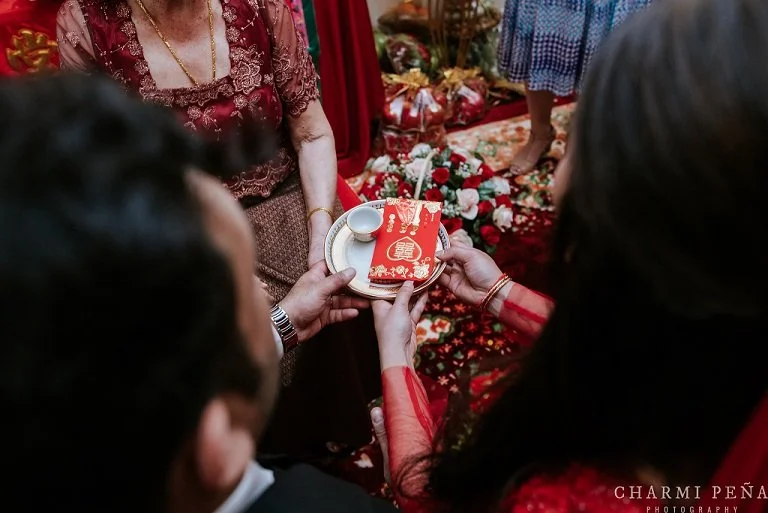Worldly Wedding Traditions to Include in Your Big Day
Weddings aren’t only a celebration of love, but a blending of two individuals’ lives and cultures. If you’re looking for ways to incorporate wedding traditions that truly honor your heritage and celebrate your culture, start here for some inspiration! Every country has its own unique ceremonies and esteemed rituals you can include during your planning process to make your wedding day that much more special.
What To Wear
Not every bride around the world wears a white dress to their wedding and, in fact, attire is normally much brighter and more colorful. White, though viewed as a symbol of purity in western culture, is typically thought of as a color of mourning in other countries.
If you have Indian heritage, you’ll most likely be wearing a colorful (oftentimes red), embellished lehenga or sari with golden brocade and rich fabric. You may also be throwing a Mehndi party the day before the wedding with your closest female friends and family, and spend hours getting intricate henna painted onto your skin. Not only is this a stunning tradition, but it has its roots in medicine, and is often used as stress relief for the bride.
Red is also a common color found in Chinese festivals because it represents luck, happiness, and celebration. For this reason, it may be the most popular color brides adorn in their Qun Kwa or cheongsam, but many other colors can also make an appearance and hold different meanings in Chinese culture. Sometimes the bride will change into as many as three different dresses throughout the course of the night. In Japanese cultures, weddings have a mixture of spiritual elements and western influence, so brides tend to wear all-white kimonos and a tsunokakushi (a hood similar to a veil) during a traditional Shinto ceremony.
What To Eat
If you’re looking to spice up your menu or dessert table, incorporating some ethnic foods or sweets may be the way to win over people’s hearts. Food is often related so closely to memories and identity, so if you have a traditional meal or treat that’s particularly special to you, then make sure to include it on your big day! You should discuss your options with caterers and cake designers to make sure all the details are perfect. If you’re having trouble with this, talk to your wedding planner, as they typically have local connections and can coordinate the perfect way to include a specialty on the menu.
For Norwegian wedding cakes, guests will enjoy a kransekake (“wreath cake”), which is made up of 18 iced almond cakes in the shape of rings, stacked up to form a cone. You can also enjoy a croquembouche in France, which are pastry balls (profiteroles) stacked up in a cone-shaped tower as well. Taking a note from a tradition in Peru, you can include a cake pull, where the bride’s closest friends pull out ribbons attached to charms from under the cake. One of these ribbons has a ring on it, and the single lady that pulls it out is destined to be the next one married! This is very similar to a bouquet toss in U.S. tradition.
Unity Ceremonies
A unity ceremony is something that can be easily incorporated into a wedding and has roots in many cultures as well. If you’re Jewish, you may be thinking of circling during the ceremony, which means that the bride (and sometimes groom) walk circles around each other to symbolize their devotion, love, and protection. Common in Mexican, Spanish, and Filipino cultures, lasso ceremonies occur after vows are spoken as the officiant places a garland or rosary around the couple. If you’re Scottish or Irish, you can try Celtic handfasting during your wedding ceremony, and wind a rope or ribbon around you and your fiancé/ fiancée’s hands as you say your vows. Talk about tying the knot!
Blended Cultures
American traditions stem from many different cultures in the end, but there are a few significant features within the ceremony and reception that have stood the test of time. Brides continue to wear white dresses and incorporate something old, new, borrowed, and blue. They may gravitate towards more neutral color palettes and themes. The couple still has a first dance and also picks close friends to be a part of their wedding party, standing next to them as they say their vows.
Incorporating aspects of your culture into a wedding ceremony is a great way to celebrate love and honor your heritage. This doesn’t have to mean that you host a three-day Indian wedding ceremony or a huge party for everyone you know. If your parents are dead set on a big, traditional wedding, trying your best to incorporate their wishes on a smaller scale may be the more affordable option. Spending all of your savings on the wedding may put you in a difficult position as you start the new chapter of your life with your significant other. Remember, you still should keep in mind post-wedding expenses like saving up to purchase a house together and starting a family when the time is right. It’s also important to have a safety net in the form of an emergency fund and put aside money as you plan for your future.
As expensive and extravagant as you believe American weddings are, Insider has determined ceremonies in the United Arab Emirates, Australia, the UK, and Kenya to be even pricier as of 2018. Whether you want to go all out with a cultural ceremony or try to blend other traditions with those popular in the U.S., make sure that you’re staying true and authentic to yourself and your spouse.



